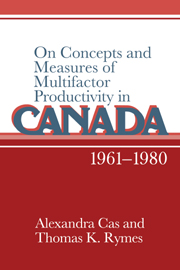Part II - Measures of multifactor productivity, Canada, 1961–1980: Introduction to the experimental estimates
Published online by Cambridge University Press: 11 September 2009
Summary
Part I of this study presented and compared the theoretical arguments behind the traditional and new measures of multifactor productivity. The new measures take into account the produced nature of capital inputs and, at the industry level, the technological interdependence involved in the production of outputs and inputs in a technically progressive world. The traditional measures do not.
Part II sets up two empirical models, one for the derivation of feasibility estimates of traditional multifactor productivity measures and the other for the new measures using an expanded input–output data base from Statistics Canada. Both measures should be regarded as experimental, for not all data problems have been resolved. The study demonstrates the potential in the use of an input–output data base for empirical studies of productivity and the feasibility of preparing Canadian estimates of the new measures of multifactor productivity.
The content of Part II is as follows.
Chapter 4 describes the input–output accounts and data base, which are the basis of the empirical model. It also defines and specifies the accounting concepts employed and limitations of the data. It goes on to present the modified input–output (I/O) model used and derives, from two different versions, the traditional and the new measures of multifactor productivity. The basic difference between these two measures lies in the measurement of the intermediate and capital inputs; that is, produced inputs. The new measure adjusts each produced input for the change in efficiency in its industry of origin, whereas the traditional measure does not.
- Type
- Chapter
- Information
- Publisher: Cambridge University PressPrint publication year: 1991



